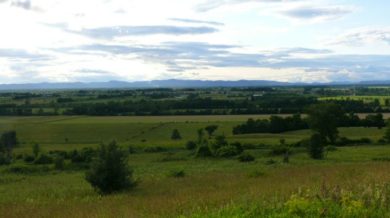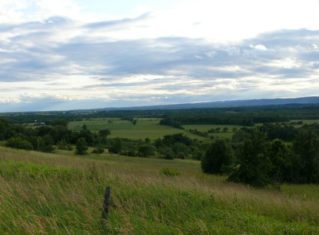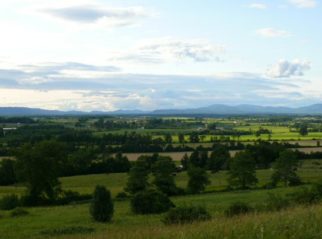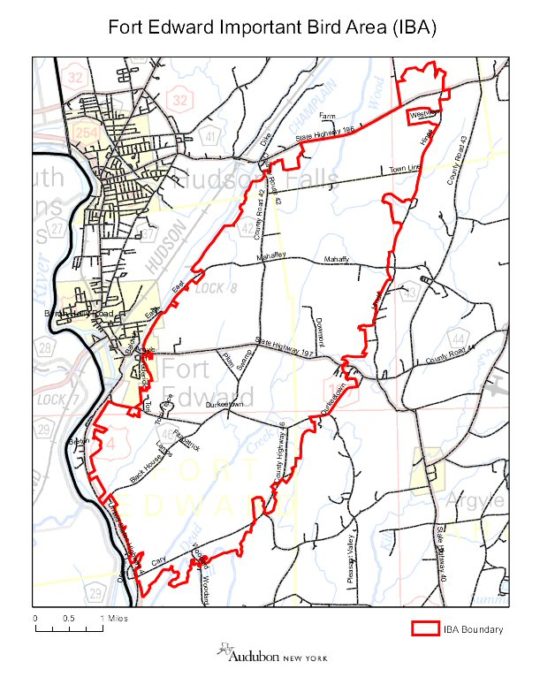Washington County Grasslands Important Bird Area

In 2014, New York State Department of Environmental Conservation finalized its purchase of 286 acres of the Washington County Grasslands Important Bird Area.
The lands were designated State Forest and hunting is allowed in season.
That same year a half-mile long trail was developed and a kiosk built at the trailhead on Blackhouse Road.

This vast birding area is comprised of the 13,000 acre Fort Edward Grasslands IBA, located east and south of the Villages of Hudson Falls and Fort Edward, and the agricultural areas in the towns of Argyle and Kingsbury contiguous to the IBA.
Containing many working farms and grassland areas interspersed with cultivated fields, small woodlots, and wetlands, this is an important breeding ground for grassland species, and is also a wintering area for large numbers of raptors.
Although most of this area is comprised of privately owned lands,¹ New York State Department of Environmental Conservation (NYSDEC) has purchased and protected almost 500 acres.
Containing many working farms and grassland areas interspersed with cultivated fields, small woodlots, and wetlands, this is an important breeding ground for grassland species, and is also a wintering area for large numbers of raptors.
Although most of this area is comprised of privately owned lands,¹ New York State Department of Environmental Conservation (NYSDEC) has purchased and protected almost 500 acres.

The birding information here will focus on the IBA lands, where birders have concentrated their efforts in the past.
As more birders visit this area and report their findings we will update this page to reflect new information.
As more birders visit this area and report their findings we will update this page to reflect new information.

Birding in the Fort Edward Grasslands
Important Bird Area
With some effort, many bird species can be found here at any time of year; however, this area is best known for its wintering population of raptors. Binoculars and cameras at times outnumber the birds, as birders and photographers flock to the area for species found here only when the lack of food forces them from their sub-arctic breeding grounds in Canada.
The open agricultural habitat supports a sizeable population of raptors. Rough-legged Hawks join the Red-tailed Hawks which are year-round residents. Short-eared Owls – a New York Endangered Species – and Northern Harriers – listed as Threatened in New York – are the stars of the show over the snow-covered landscape. Harriers will be seen hunting low over the fields until late afternoon, when the Short-eared Owls will leave their daytime perches to forage over the grasslands.
Blackhouse, Fitzpatrick, Plum, and Swamp Roads are some of the areas these species frequent.
Species also using the grassland habitat in winter are Snow Bunting, Horned Lark, and Northern Shrike. Eastern Meadowlarks were seen often in open fields during the winter of 2006-2007; a Snowy Owl was photographed that winter as well and a Peregrine Falcon* was added to the IBA species list as a winter visitor. Somewhat surprisingly, Eastern Bluebirds and Carolina Wren can be found in “edge” habitat.
With some effort, many bird species can be found here at any time of year; however, this area is best known for its wintering population of raptors. Binoculars and cameras at times outnumber the birds, as birders and photographers flock to the area for species found here only when the lack of food forces them from their sub-arctic breeding grounds in Canada.
The open agricultural habitat supports a sizeable population of raptors. Rough-legged Hawks join the Red-tailed Hawks which are year-round residents. Short-eared Owls – a New York Endangered Species – and Northern Harriers – listed as Threatened in New York – are the stars of the show over the snow-covered landscape. Harriers will be seen hunting low over the fields until late afternoon, when the Short-eared Owls will leave their daytime perches to forage over the grasslands.
Blackhouse, Fitzpatrick, Plum, and Swamp Roads are some of the areas these species frequent.
Species also using the grassland habitat in winter are Snow Bunting, Horned Lark, and Northern Shrike. Eastern Meadowlarks were seen often in open fields during the winter of 2006-2007; a Snowy Owl was photographed that winter as well and a Peregrine Falcon* was added to the IBA species list as a winter visitor. Somewhat surprisingly, Eastern Bluebirds and Carolina Wren can be found in “edge” habitat.
![grassnoha11222006 [Photo:A Northern Harrier hunts over the hayfields.]Additional uncommon species that have been recorded in the IBA during the winter months are Barred Owl, Merlin, and Golden Eagle*. The grasslands in spring hosts many Killdeer - their calls can be heard in every field, as can the bubbly, gurgling song of the Bobolink, recently arrived after a migration of over 5,000 miles. Another long-distance migrant, the Upland Sandpiper, flies over 7,000 miles to return to our area each spring. Also listed as "Threatened" in New York state, loss of grassland habitat is a major reason for the decline of this species. Evidence of breeding was found as recently as the summer of 2007. Other important summer breeding species found in the grasslands complex are American Kestrel, Grasshopper, Savannah, and Vesper Sparrows. Henslow's Sparrow** was also recorded in 2006. American Woodcock, Eastern Bluebird, Baltimore Oriole, and Orchard Oriole have all been recorded here as well. Spring and fall are also the times to seek out the few wetlands in the IBA. Although there is little public access to Dead Creek, which intersects the IBA in a north-south direction, areas where this creek crosses the roads can be very productive. Songbirds can be concentrated in these wet areas during spring migration.](https://www.southernadirondackaudubon.org/wp-content/uploads/2021/11/grassnoha11222006-409x304.jpg)
[Photo:A Northern Harrier hunts over the hayfields.]
Additional uncommon species that have been recorded in the IBA during the winter months are Barred Owl, Merlin, and Golden Eagle*. The grasslands in spring hosts many Killdeer – their calls can be heard in every field, as can the bubbly, gurgling song of the Bobolink, recently arrived after a migration of over 5,000 miles. Another long-distance migrant, the Upland Sandpiper, flies over 7,000 miles to return to our area each spring. Also listed as “Threatened” in New York state, loss of grassland habitat is a major reason for the decline of this species. Evidence of breeding was found as recently as the summer of 2007. Other important summer breeding species found in the grasslands complex are American Kestrel, Grasshopper, Savannah, and Vesper Sparrows. Henslow’s Sparrow** was also recorded in 2006. American Woodcock, Eastern Bluebird, Baltimore Oriole, and Orchard Oriole have all been recorded here as well. Spring and fall are also the times to seek out the few wetlands in the IBA. Although there is little public access to Dead Creek, which intersects the IBA in a north-south direction, areas where this creek crosses the roads can be very productive. Songbirds can be concentrated in these wet areas during spring migration.
Additional uncommon species that have been recorded in the IBA during the winter months are Barred Owl, Merlin, and Golden Eagle*. The grasslands in spring hosts many Killdeer – their calls can be heard in every field, as can the bubbly, gurgling song of the Bobolink, recently arrived after a migration of over 5,000 miles. Another long-distance migrant, the Upland Sandpiper, flies over 7,000 miles to return to our area each spring. Also listed as “Threatened” in New York state, loss of grassland habitat is a major reason for the decline of this species. Evidence of breeding was found as recently as the summer of 2007. Other important summer breeding species found in the grasslands complex are American Kestrel, Grasshopper, Savannah, and Vesper Sparrows. Henslow’s Sparrow** was also recorded in 2006. American Woodcock, Eastern Bluebird, Baltimore Oriole, and Orchard Oriole have all been recorded here as well. Spring and fall are also the times to seek out the few wetlands in the IBA. Although there is little public access to Dead Creek, which intersects the IBA in a north-south direction, areas where this creek crosses the roads can be very productive. Songbirds can be concentrated in these wet areas during spring migration.
![grassfitzpatrickrd [Photo: Fitzpatrick Road is famous among local birders for its
population of Short-eared Owls.
]Also during "spring melt," a small, marshy area on Town Line Road will hold large numbers of waterfowl, including Northern Pintail, Gadwall, Green-winged Teal, and Wood Duck. Check this area also as birds move south in the fall. Other interesting species recorded in the recent past are American Bittern, Osprey, and Cedar Waxwing. As development encroaches on this agricultural area, traffic is increasing, making "roadside" birding hazardous in some areas at certain times of day. State routes 196, 197 and 4 are busy roads with high-speed traffic; use caution when birding these roads. The same is true for Washington county routes 46 and 42. This IBA has long been an important summer breeding area and winter home for bird species that are rapidly declining in the eastern part of this country. We in Southern Adirondack Audubon hope that conservation efforts will slow the habitat loss, and ensure that future generations of birds will continue to nest and winter here.
-----------------------------
*denotes species listed as "Endangered" in New York state
**denotes species listed as "Threatened" in New York state](https://www.southernadirondackaudubon.org/wp-content/uploads/2021/11/grassfitzpatrickrd-409x304.jpg)
[Photo: Fitzpatrick Road is famous among local birders for its
population of Short-eared Owls.
]
Also during “spring melt,” a small, marshy area on Town Line Road will hold large numbers of waterfowl, including Northern Pintail, Gadwall, Green-winged Teal, and Wood Duck. Check this area also as birds move south in the fall. Other interesting species recorded in the recent past are American Bittern, Osprey, and Cedar Waxwing. As development encroaches on this agricultural area, traffic is increasing, making “roadside” birding hazardous in some areas at certain times of day. State routes 196, 197 and 4 are busy roads with high-speed traffic; use caution when birding these roads. The same is true for Washington county routes 46 and 42. This IBA has long been an important summer breeding area and winter home for bird species that are rapidly declining in the eastern part of this country. We in Southern Adirondack Audubon hope that conservation efforts will slow the habitat loss, and ensure that future generations of birds will continue to nest and winter here.
—————————–
*denotes species listed as “Endangered” in New York state
**denotes species listed as “Threatened” in New York state
Also during “spring melt,” a small, marshy area on Town Line Road will hold large numbers of waterfowl, including Northern Pintail, Gadwall, Green-winged Teal, and Wood Duck. Check this area also as birds move south in the fall. Other interesting species recorded in the recent past are American Bittern, Osprey, and Cedar Waxwing. As development encroaches on this agricultural area, traffic is increasing, making “roadside” birding hazardous in some areas at certain times of day. State routes 196, 197 and 4 are busy roads with high-speed traffic; use caution when birding these roads. The same is true for Washington county routes 46 and 42. This IBA has long been an important summer breeding area and winter home for bird species that are rapidly declining in the eastern part of this country. We in Southern Adirondack Audubon hope that conservation efforts will slow the habitat loss, and ensure that future generations of birds will continue to nest and winter here.
—————————–
*denotes species listed as “Endangered” in New York state
**denotes species listed as “Threatened” in New York state
![grassrlha113007 [Photo: A dark-phase Rough-legged Hawk takes advantage
of a fencepost on a local farm. ]](https://www.southernadirondackaudubon.org/wp-content/uploads/2021/11/grassrlha113007-409x304.jpg)
[Photo: A dark-phase Rough-legged Hawk takes advantage
of a fencepost on a local farm. ]
![grassseow030607 [Photo: Short-eared Owls roosting in an evergreen tree. ]](https://www.southernadirondackaudubon.org/wp-content/uploads/2021/11/grassseow030607-409x304.jpg)
[Photo: Short-eared Owls roosting in an evergreen tree. ]